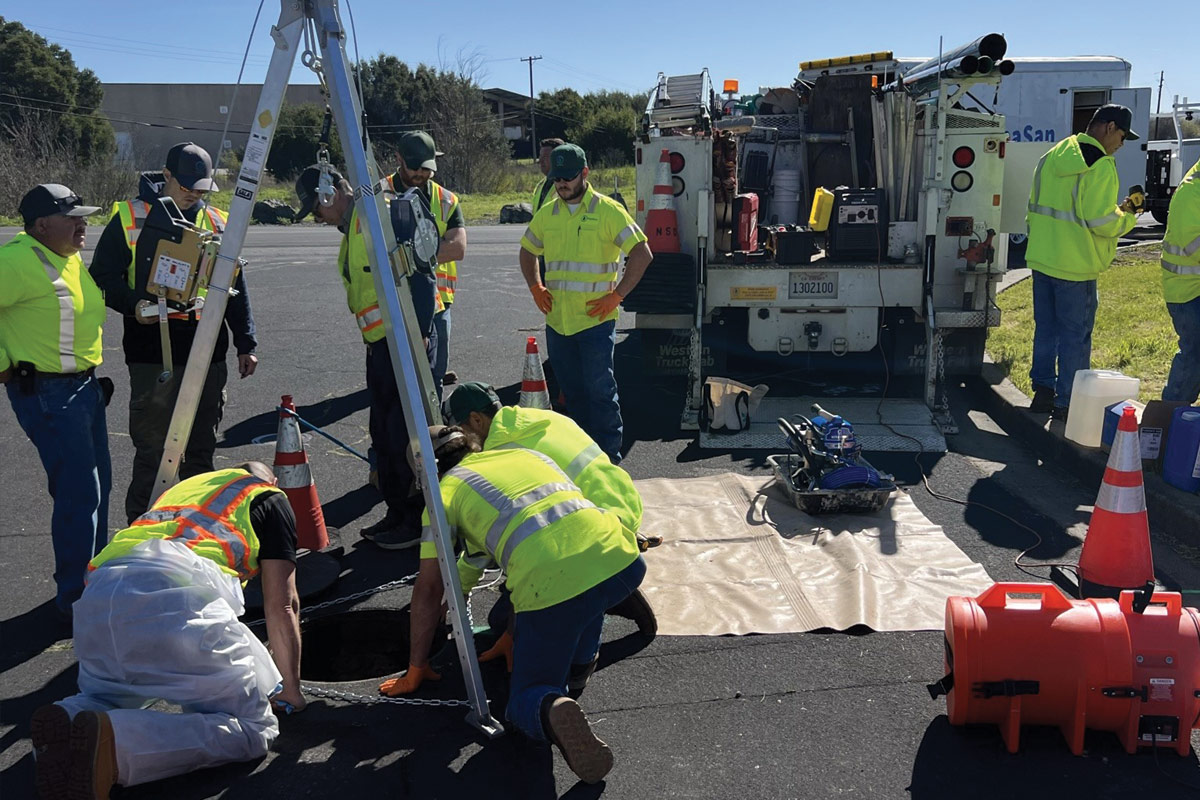
Phase III High-Level Interceptor Rehab in Toronto Requires Sliplining, CIPP
Toronto Water is known across North America as being one of the leaders when it comes to the amount of trenchless rehabilitation works completed on an annual basis.
Recently the division undertook a project that included the trenchless rehabilitation of the upper reaches of the High-Level Interceptor (HLI), one of the three interceptors serving the City of Toronto. Built in 1912, using open cut construction, the 54-in. brick interceptor runs below Dufferin Street, Liberty Street and King Street near Toronto’s downtown area.
Stantec was charged with designing the project, which included assessing the existing condition of the 110-year-old brick sewer and preparing conceptual, preliminary and detailed designs for the required rehabilitation work. Ultimately it was decided to break the work into three phases, with each phase being sent to tender individually. Clearway Construction, of Maple, Ontario, was awarded the contract for Phase III in September 2021 with expected completion by August 2022.
Phase III included the rehabilitation of approximately 880 m of the interceptor sewer running from MH101-094 to MH101-088, and the replacement of the associated maintenance holes (MHs). The project area took place between King Street West at Sudbury Street and Liberty Street at Fraser Avenue in the Liberty Village neighbourhood of Toronto’s Ward 10 (Spadina-Fort York).
The design work was supported by topographical and utility surveys, while additional field data collected during detailed design included Quality Level “A” subsurface utility engineering (SUE) surveys, chamber inspections, geotechnical study and multi-sensory LIDAR investigation of critical pipe segments.

Selecting the Right Trenchless Methods
The brick sewer has a 54-in. internal diameter and circular geometry. The hydraulic analysis suggests that a minimum reduction of the cross-sectional area is needed to meet the projected flow capacity, as additional population growth is anticipated within the catchment area of the interceptor. For these reasons, cured-in-place pipe (CIPP) was selected as the preferred rehabilitation methodology, providing a fully structural, monolithic, jointless, corrosion resistant barrier with a 50-year design life, while maintaining or even increasing the flow capacity of the interceptor.
The ability of CIPP to negotiate curves within the interceptor’s alignment was another key advantage, minimizing the number of insertion points. Staging areas were selected such that the CIPP liner was installed downstream and upstream from a single MH access location, minimizing the impact on downtown traffic, commercial establishments and residents.
A unique challenge associated with the rehabilitation of the interceptor was the reach between MH101-090 and MH101-089, running along King Street and beneath a major Metrolink elevated bridge structure, serving the train traffic coming into Union Station.
During construction of the railway bridge the roadway was lowered to enable sufficient clearance under the bridge, resulting in a grade conflict between the new road elevation and the overt of the interceptor. The brick sewer was removed and replaced with approximately 30 m of circular 54-in. circular concrete pipe, which transitioned to a 44-in. by 64-in. inverted basket handle (IBH) concrete pipe. In this approximately 205 m section of IBH concrete pipe, the top of the pipe, became the south sidewalk of King Street.

The IBH Challenge
IBH geometry posed significant challenge from a rehabilitation perspective in terms of the structural capacity of a liner with such unique geometry, staging areas close to the foundation of the railway bridge’s embankment, and the proximity to King Street, a critical transportation corridor home to multiple Toronto Transit Commission (TTC) streetcar and bus lines.
The solution selected for this non-circular section of the interceptor was segmental glass reinforced pipe (GRP) liner. Manufactured by Channeline, the liner is custom manufactured to fit the IBH geometry as established by the 3D LIDAR survey.
Another unique solution was the development of a liner product that provided a hydraulically smooth transition between the CIPP lined 54-in RCP and the GRP lined IBH at one of the rehabilitation works. The general contractor, Clearway Construction, and Stantec collaborated on the development of a custom innovative solution for this complex transition section. A transition was not needed at the other end because the IBH section terminated at a maintenance hole with the circular portion continuing on the other side.

Bypassing the Flow
The utilization of CIPP for the rehabilitation of the sewer necessitated the installation of a full flow bypass for the High Level Interceptor capable of handling wet weather flow with 100 per cent redundancy. A complex bypass system was developed, with a global bypass plan designed to handle flows into the project area comprising all major sources of dry weather flow and local bypasses plans for local service connections. Clearway installed and operated the bypass — consisting of twin 18-in. HDPE pipes and designed to convey more than 550 L/S — with pumps rented from Toromont CAT.
Much of the bypass ran on surface or underground; however, a unique challenge faced the design team. How to convey the bypass across King Street West at the railway bridge? The street is a major traffic artery housing tracks and overhead powerlines for the street cars and serves as the right-of-way for numerous buried utilities.
“Definitely the significant bypass was the most difficult challenge of the project. We had to get it over and above a major downtown arterial road while maintaining [traffic on] the TTC tracks and public traffic through the area,” says Richard Svirga, project manager, Clearway Construction. “This was the first time I’ve put up two 18-in. HDPE bypass pipes up and over a major road and along a railway structure. I don’t think I’ve ever seen a bypass like that before.”
Temporary open cutting of the street was deemed impractical. The solution developed was an arial bridge, parallel to — but independent of — the railway bridge, that enables the bypass pipes to cross King Street West without impacting traffic flow.

The bypass setup required a scaffold to carry the weight of the pipes when filled with effluent up and over the road, pumps and reliefs at bottom in case something got stuck and the bypass needed cleared, as well as an air release at the top to release any trapped air. Svirga notes it’s similar in design to a pressure pipe sanitary system with elevation changes.
“It’s not a regular occurrence, that’s for sure. The depth that we would have had to go to dig to put the temporary bypass in just didn’t make sense,” Svirga says.
Trenchless rehabilitation work of a major, 110-year-old sewer in the heart of Canada’s largest metropolitan area, carries many challenges, as record drawings can tell only part of the story and at times a few inches can make the difference between successful placement of a manhole structure and a design change mid-construction.
The City, Stantec and Clearway Construction worked collaboratively on innovative solutions for challenges encountered during the construction, to bring this complex project to successful completion, extending the service life of a critical interceptor for decades to come.
Erez Allouche, P.Eng., is tunneling and trenchless practice technology leader – trenchless technologies at Stantec. Mike Kezdi is the managing editor of Trenchless Technology Canada.




